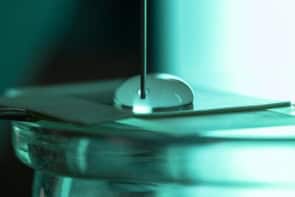
New insights into why heat transfer between objects is enhanced at very short separations have been gleaned by Keunhan Park and colleagues at the University of Utah and University of Pittsburgh in the US. The team made exquisitely precise measurements of how heat moves between two quartz plates that are positioned just 200 nm apart. They found that energy transfer is enhanced by about 45 times at tiny separations, which they ascribe to the coupling of surface photon polaritons across the gap between the plates.
Normally, the heat transfer between two objects at different temperatures can be approximated by assuming that the objects are “black bodies”. These are ideal entities that absorb all radiation falling on them and emit thermal radiation according to Planck’s law. Physicists have known for some time that this breaks down when objects get to within a few hundred nanometres of each other, where they exchange heat much faster than predicted by the black-body approximation. Indeed, this “near-field” enhancement has already been used in some technologies including heat extraction and thermophotovoltaic systems.
However, more widespread use of the enhancement has been hampered by a poor understanding of the effect – which is a result of significant experimental difficulties in measuring heat transfer between objects separated by just a few hundred nanometres. These challenges include controlling unwanted heat flow and achieving precise control over the orientation and separation of the two objects.
Parallel lines
Now, Park and colleagues have measured radiative heat transfer between two macroscopic plates of quartz each measuring 5×5 mm and separated by a distance that they could vary between 200-1200 nm. A key feature of their experimental apparatus is that they can keep the plates parallel to within a fraction of a millidegree. Indeed, by varying the angle between the plates, they were able to show that heat transfer is extremely sensitive to how parallel the plates are – dropping off by 5% when the plates are misaligned by just 3 millidegrees.
As well as confirming that radiative heat transfer is enhanced over short distances, the experiments suggest that surface phonon polaritons are responsible for the boost. Phonons are particle-like acoustic excitations that occur in solids. Quartz is a polar crystal and this means that its phonons can generate oscillating electric fields. These fields can couple with photons at the surface of quartz to create surface phonon polaritons, which are photon-like excitations. Measurements reveal that the heat transfer is proportional to one over the square of the separation between the plates, which agrees with the theoretical calculations of how energy is transferred across the gap by surface plasmon polaritons.
Writing in Physical Review Letters, the team says that their technique could be used to measure the near-field thermal radiation properties of a range of different materials and structures.



